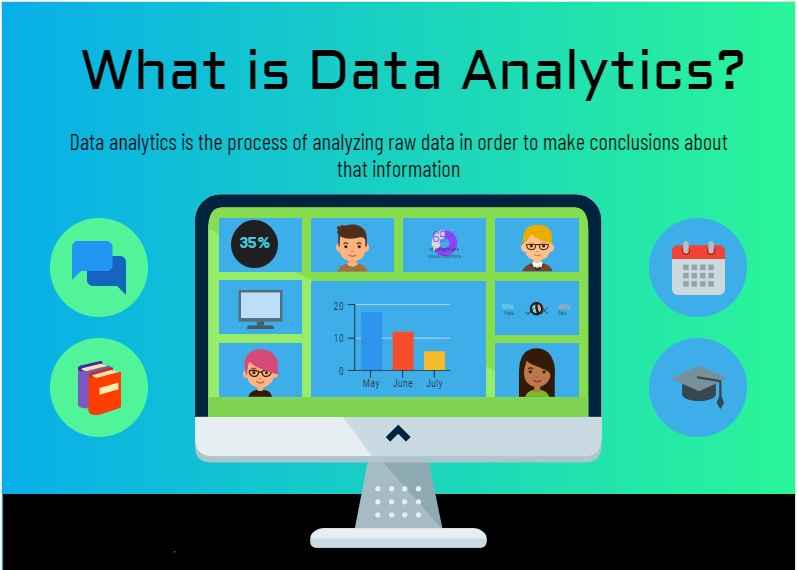In the era of information abundance, data analytics has emerged as a transformative force, reshaping the way businesses operate and make decisions. This article delves into the intricacies of data analytics, exploring its significance, key methodologies, challenges, and the profound impact it has on driving innovation and informed decision-making in the contemporary business landscape.
:max_bytes(150000):strip_icc()/data-analytics-4198207-1-ad97301587ac43698a095690bc58c4c1.jpg)
Understanding Data Analytics
Extracting Insights from Data
At its core, data analytics involves the process of examining, cleaning, transforming, and modeling data to uncover meaningful patterns, draw conclusions, and support decision-making. It encompasses a spectrum of techniques, from basic statistical analysis to advanced machine learning algorithms, all aimed at extracting actionable insights from vast and complex datasets.
Types of Data Analytics
- Descriptive Analytics: This type focuses on summarizing historical data to provide insights into what has happened. It lays the groundwork for understanding past trends and patterns.
- Predictive Analytics: By leveraging statistical algorithms and machine learning techniques, predictive analytics forecasts future outcomes based on historical data. Businesses use this to make informed decisions and anticipate trends.
- Prescriptive Analytics: Taking it a step further, prescriptive analytics suggests actions to optimize outcomes. It provides recommendations on what steps businesses should take to achieve desired goals or mitigate potential issues.
The Significance of Data Analytics in Business
Informed Decision-Making
Data analytics empowers businesses to make informed and evidence-based decisions. By analyzing historical data and real-time information, organizations gain valuable insights into market trends, customer behaviors, and operational performance, enabling them to strategize effectively.
Operational Efficiency and Optimization
Efficiency lies at the heart of data analytics. Businesses leverage analytics to streamline operations, identify bottlenecks, and optimize processes. This leads to cost savings, improved resource allocation, and enhanced overall efficiency.
Key Methodologies in Data Analytics
Machine Learning and Predictive Modeling
Machine learning algorithms form the backbone of predictive analytics. These algorithms analyze historical data to identify patterns and relationships, enabling businesses to make predictions about future outcomes. From customer behavior prediction to demand forecasting, machine learning contributes to informed decision-making.
Big Data Analytics
In the age of big data, traditional data processing methods are insufficient. Big data analytics involves processing and analyzing massive datasets that traditional databases cannot handle. Technologies like Hadoop and Spark play a crucial role in extracting insights from vast and diverse data sources.
Challenges in Implementing Data Analytics
Data Quality and Accuracy
One of the primary challenges in data analytics is ensuring the quality and accuracy of the data being analyzed. Inaccurate or incomplete data can lead to flawed insights and misguided decisions. Businesses must invest in data governance and quality assurance processes.
Privacy and Security Concerns
As businesses handle increasingly sensitive data, privacy and security concerns become paramount. Protecting customer information and complying with data protection regulations are critical aspects of responsible data analytics implementation.
Strategies for Successful Data Analytics Implementation
Define Clear Objectives and KPIs
Before diving into data analytics, businesses must define clear objectives and key performance indicators (KPIs). Understanding what insights are needed and aligning analytics efforts with organizational goals ensures a focused and impactful implementation.
Invest in Data Literacy and Talent
Building a data-driven culture requires investing in data literacy across the organization. Training employees to understand and interpret data fosters a collaborative environment. Additionally, businesses must attract and retain talent with expertise in data analytics and interpretation.
Data Analytics in Industry Verticals
Healthcare: Predictive Diagnostics and Patient Care
In the healthcare industry, data analytics is used for predictive diagnostics, patient care optimization, and resource allocation. Analyzing patient data helps identify early signs of diseases, predict treatment outcomes, and enhance overall healthcare delivery.
Retail: Personalized Marketing and Inventory Management
Retail businesses leverage data analytics for personalized marketing campaigns and efficient inventory management. Understanding customer preferences allows retailers to offer targeted promotions, improve the customer shopping experience, and optimize stock levels.
The Future Landscape of Data Analytics
Integration with Artificial Intelligence
The future of data analytics is closely intertwined with artificial intelligence (AI). AI algorithms enhance the capabilities of data analytics by automating complex tasks, enabling faster and more accurate analysis, and uncovering deeper insights from data.
Real-Time Analytics and Edge Computing
The demand for real-time insights is growing, driving the development of real-time analytics and edge computing. Businesses aim to make decisions on the fly, requiring analytics processes to operate at the edge, closer to the data source.
Conclusion: A Data-Driven Future
In conclusion, data analytics is not just a technological tool; it’s a strategic enabler that propels businesses toward a data-driven future. As technology continues to advance, businesses that embrace data analytics, invest in talent and technology, and navigate challenges responsibly will not only stay competitive but also shape the landscape of their industries. The ability to extract actionable insights from data is a powerful asset in the dynamic and evolving business landscape.
Read More : Customer Centricity: Elevating Businesses through Focused Customer Experiences








